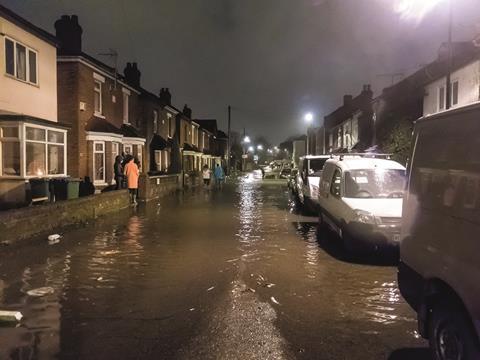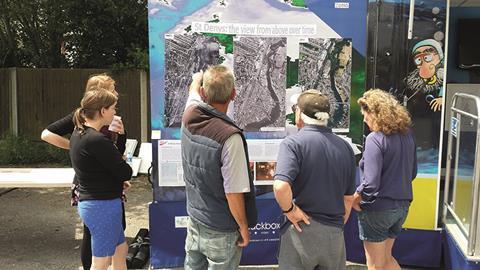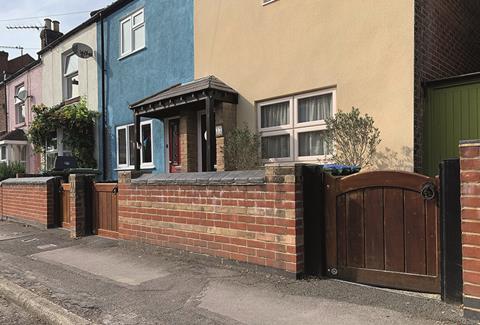A project to build flood resilience in the St Denys area of Southampton put the local community firmly at its heart, with a group of knowledgeable and committed residents heavily involved from start to finish. Josephine Smit reports

It is not often that those delivering a construction or infrastructure scheme describe the community in whose midst they are working as part of their team. But that is how former Southampton city council project manager Bernadine Maguire sums up the relationship with the small but committed community group established by the local authority to work with it on a flood resilience project.
The project has helped safeguard residents in two streets in the St Denys area of the city through the provision of property-level protection (PLP), equipping individual homes with flood doors, turning garden walls into flood defences, and other tailored solutions.
Throughout the complex process of assessing local flood risk and delivering protective measures on a home-by-home basis, the project has tapped into the community’s own social networks and local knowledge to create buy-in, long-term resilience and social value.
Getting a picture of the problem
The St Denys neighbourhood is the second-most densely populated area of Southampton and borders the River Itchen estuary. Maguire, who is now principal flood risk and coastal consultant at Aecom, explains that it was highlighted for action in Southampton’s 2012 coastal flood and erosion risk strategy.

“The flood envelope in that area is quite narrow, so we identified the highest-risk area, which was Priory Road and Adelaide Road. Not all homes there had experienced flooding, but residents would have seen shallow flooding in the road.” In all, 48 properties were assessed to be at a 20% risk of a major flood event in any given year.
A government funding programme offered support for a community-focused approach. The Department for Environment, Food and Rural Affairs’ (Defra) Flood Resilience Community Pathfinder scheme grew out of the recommendations of Sir Michael Pitt’s review of the 2007 floods, which included the promotion of local solutions to local flood problems.
The Defra pathfinder programme backed 13 projects, and in 2013 it provided almost £500,000 for the St Denys scheme. This funding was used to support the high level of engagement demanded by the community approach and for homeowners to carry out specific flood protection measures.
We had some very clued-up and enthusiastic members of the community, and everything went through them
Bernadine Maguire, project manager
“The approach was bottom up rather than top down,” Maguire says. “Usually an organisation [just] says what it is going to do; there would be engagement, but it would be quite technical and a community’s ability to influence the solution would be quite limited. This was about trying to get the community to come up with the solution and to be more engaged in spreading the word about flood risk.”
PLP measures were prioritised because of the nature of the flooding. Maguire continues: “The river is tidal at that point and so the dominant flooding was tidal, but residents had talked of water backing up through drains. We did CCTV inspections and monitoring and found there were interactions between tidal river water, groundwater and surface water there.”
That complex picture was set out in a flood risk interactions study by Aecom, which has been working with the council to improve flood resilience across the city and delivered the 2012 coastal flood and erosion risk management strategy. Jonathan Short, associate director with the consultant and a coastal specialist, says: “The challenge was trying to unpick and understand the various sources of flooding here and how they interact, and then convey that to the community.”
Working together towards solutions
A larger-scale solution, such as a flood wall along the riverbank, would not have tackled the interactions between the different flooding sources and would have been significantly more costly than PLP. Crucially, it was also not what residents wanted, as those living on the riverside valued their garden space, jetties and access to the water.
“This was always going to have a community-level response,” says Maguire. “Residents were happy with that – and to live with an element of risk.”
Working with Aecom and the National Flood Forum charity, the council engaged with the community from the earliest stages and established the working group to be its partner in the project. Short recalls evening meetings spent talking through the risks using computer models and graphs.
A consultation event based in a bus, drop-in events in the nearby community centre or pub, a flood fair event and regular newsletters all helped to encourage residents whose homes were most at risk to get involved in the initiative and increase awareness among the broader community. At these events, suppliers were invited to showcase products such as flood doors and non-return valves, so that residents could see and become familiar with their flood-protection options.

The working group was more closely involved. “We had some very clued-up and enthusiastic members of the community, and everything went through them,” Maguire recalls. “At some points in the project we were on site every week. We discussed everything with them, including presenting the interactions study to them.”
The project team tapped into the on-the-ground knowledge of the working group. “They knew the water levels in the estuary that would result in flooding,” Short says, by way of example.
The Priory Road and Adelaide Road homes presented different challenges. Priory Road’s homes flank the river on one side and house mostly middle-aged and older owner-occupiers. Adelaide Road intersects Priory Road at an angle, extending away from the river, and many of its homes are occupied by private renters.
Short says: “It became clear as we engaged with the community that the residents of Priory Road were aware of flood risk. They were among around 100 people who came to the meeting about the flood strategy. Their houses backed onto the river, so they had the most direct experience of flooding.”
The response from residents in Adelaide Road was very different, according to Maguire. “Because the homes were rented and didn’t back onto the river, the residents hadn’t been too aware of flooding and didn’t want to engage.” So, while 100% of homes in Priory Road wanted to participate in the project, only one home in Adelaide Road did.
Every home participating in the project underwent an individual survey, giving advice on what steps should be taken to improve their flood resilience. Priory Road homes backing onto the river were provided with PLP measures, with each homeowner allowed a grant of up to £7,500.
Accommodating individual needs
Maguire explains how the spend needed to be tailored not only to each property’s risk profile but also to the needs of its particular residents. “There was around a £1,000 difference in the price between flood boards and a flood door, so for vulnerable residents who couldn’t physically put a flood board in place we advocated the more expensive flood door.”

One elderly couple who couldn’t attend resident meetings received at-home visits. “We worked with what each householder needed. There were standard products, but every house needed something different,” Maguire adds.
On the opposite side of Priory Road, the project team were able to replace all the individual front garden walls with a single flood wall featuring watertight gates. That action needed to be led by the community as all residents had to agree in order for the solution to work.
“At the stage when we came up with that proposal we hadn’t engaged with everybody, but residents living on the river side got everyone to sign up,” Maguire says. “They are all neighbours and had a sense of shared risk.”
> Social value matters: Survey results show values are changing
> Meridian Water: From the ground up
As it proved impossible to secure resident engagement for the Adelaide Road homes, the project team came up with an alternative solution. It secured the support of one resident whose garden wall backed onto Priory Road, and set up here a temporary barrier and pump able to reduce the flow of floodwater sufficiently to safeguard Adelaide Road’s homes. Again, the other residents enabled the solution by facilitating conversations with the resident concerned.
Increased community cohesion
The project was completed in 2015, and Defra’s report evaluating the pathfinder projects for that year points to early benefits in St Denys in terms of increased community cohesion and mutual support. This was put to the test when a 1.2m storm surge occurred during the project works in 2014. This proved the Aecom modelling correct and persuaded at least one householder it would be sensible to sign up to have PLP.
We had to do a lot of explaining in plain English. The way we present information to the public now involves more jargon-busting and messaging tailored to the local community
Jonathan Short, Aecom
Local residents have taken ownership of their resilience, having established a flood action group, a community flood plan, flood wardens and their own information-packed website. A further council scheme focusing on properties with slightly lower flood risk has since secured 100% take-up.
Short says the St Denys experience has been a lesson in how to take projects to the public, and one that Aecom has since applied elsewhere – including on the Jersey coast, where a roving exhibition was used to actively take the plans out to the harder-to-reach public in a more informal setting.
The Southampton project also provided a reminder of the fundamentals of communication. “We had to do a lot of explaining in plain English,” Short adds. “The way we present information to the public now involves more jargon-busting and messaging tailored to the local community.”
For Maguire, the project was time-intensive but she says it was ultimately rewarding both for the professional team and for the community. “Social value wasn’t really a commonly used term when we started this; it was more about getting the community involved. Now there is a legacy and the initiative is moving forward.”
Click here for the Social Value in Action digital supplement




























No comments yet